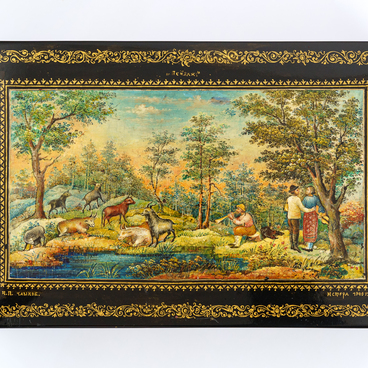For several centuries, Mstyora has been known for its skilled craftsmen and artists. Historical documents mention that in the 18th century, more than 30 icon painters worked in the settlement. Over time, several workshops were established in Mstyora that employed “lichniki” (icon painters who painted only the faces of saints), “dolichniki” (icon painters who painted clothes and landscape), coiners, decorators, gilders and other specialists.
In the second half of the 19th century, along with hand-painted icons, inexpensive printed images became widespread. They were often decorated with foil — paper-thin metal sheets. They were called “podfolezhnitsy” (literally — “under foil”).
By the late 19th century, a certain style of icon painting was developed in the settlement of Mstyora. The Mstyora icon can be distinguished by a colored background, which transitions from light tones to more saturated dark ones. Gold leaf is traditionally used instead of white paint to create highlights on the robes of saints.
There are several iconographic types of images of Christ. According to tradition, it is customary to depict Jesus Christ at the age of His ministry, when He was about 30 years old. The iconographic type “Emmanuel” is an exception. Such icons depict the young Savior, referring to Isaiah’s prophecy about the birth of a child, who will be named Emmanuel. This name is of Hebrew origin and means “God is with us.” Iconography of this type is very popular in Russia and other Orthodox countries.
The icon “Christ Emmanuel” presented at the exhibition “The Art of Mstyora” was painted in the late 19th — early 20th century by an unknown master. This is a shoulder-length image of the Savior. The gaze of His brown eyes is directed at the viewer. A pattern of intertwining stems with small leaves is embroidered with golden threads on His golden-yellow chiton (a form of tunic); the golden collar is embellished with precious stones. The blue himation (mantle) is decorated with thin lines made with gold leaf.
The background is painted in the traditional
manner, with the transition from light blue on top to dark blue on the bottom.
The fields of the icon are covered with gold leaf. A thin strip of brown paint
is drawn along the outer edge of the field — this is a special frame that
symbolically separates the physical world from the sacred world of the icon.


